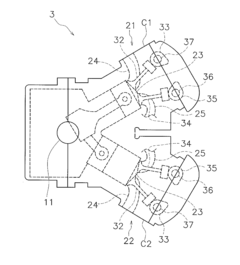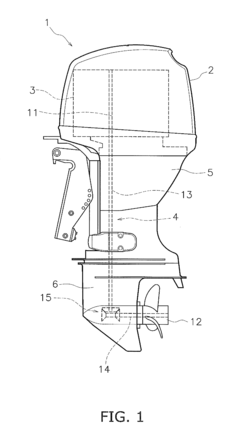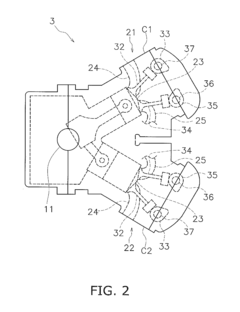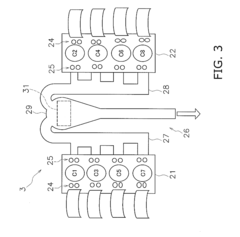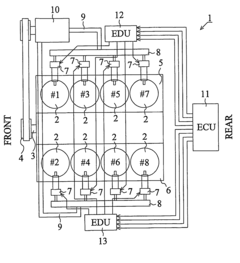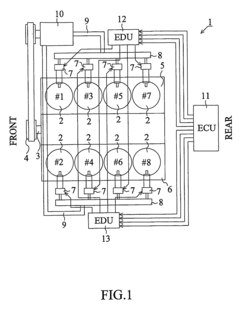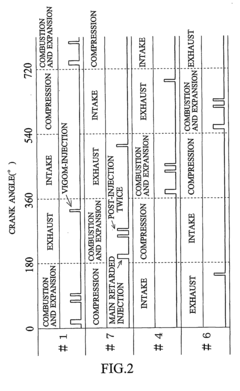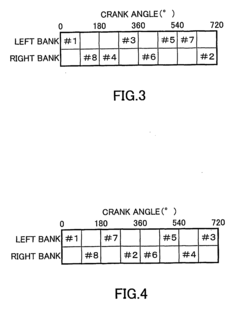V8 Engine Cylinders: Exploring Variations and Effects
JUL 4, 20259 MIN READ
Generate Your Research Report Instantly with AI Agent
Patsnap Eureka helps you evaluate technical feasibility & market potential.
V8 Engine Evolution
The V8 engine has undergone significant evolution since its inception, marking key milestones in automotive engineering. Initially developed in the early 20th century, the V8 configuration quickly gained popularity due to its compact design and impressive power output. The 1930s saw widespread adoption of V8 engines in American automobiles, setting the stage for decades of refinement.
Post-World War II, V8 engines experienced a surge in development, with manufacturers focusing on increasing displacement and power. The 1950s and 1960s are often referred to as the "Golden Age" of V8 engines, characterized by high-performance muscle cars and the introduction of overhead valve (OHV) designs. This era saw the emergence of iconic V8s like the Chevrolet Small-Block and Ford Windsor engines.
The 1970s brought new challenges with stricter emission regulations and fuel economy concerns. This led to a shift in V8 engine design, emphasizing efficiency over raw power. Manufacturers began implementing technologies such as electronic fuel injection and catalytic converters to meet these new standards while maintaining performance.
The 1980s and 1990s witnessed a renaissance in V8 technology. Computer-controlled engine management systems allowed for precise tuning, improving both performance and efficiency. This period also saw the introduction of aluminum block V8s, significantly reducing engine weight and enhancing overall vehicle dynamics.
The turn of the millennium brought about a new era of V8 engine development, focusing on balancing power with environmental responsibility. Variable valve timing, direct fuel injection, and cylinder deactivation technologies became commonplace, allowing V8 engines to deliver impressive performance while meeting increasingly stringent emissions standards.
Recent years have seen a trend towards downsizing and turbocharging V8 engines. This approach aims to maintain power output while reducing fuel consumption and emissions. Additionally, the integration of hybrid technologies with V8 engines has emerged as a way to further enhance efficiency without sacrificing the characteristic V8 experience.
Throughout its evolution, the V8 engine has consistently adapted to changing market demands and regulatory requirements. From its early days as a symbol of American automotive prowess to its current status as a high-performance, technologically advanced powerplant, the V8 continues to evolve, showcasing the automotive industry's ability to innovate and refine a classic engine configuration.
Post-World War II, V8 engines experienced a surge in development, with manufacturers focusing on increasing displacement and power. The 1950s and 1960s are often referred to as the "Golden Age" of V8 engines, characterized by high-performance muscle cars and the introduction of overhead valve (OHV) designs. This era saw the emergence of iconic V8s like the Chevrolet Small-Block and Ford Windsor engines.
The 1970s brought new challenges with stricter emission regulations and fuel economy concerns. This led to a shift in V8 engine design, emphasizing efficiency over raw power. Manufacturers began implementing technologies such as electronic fuel injection and catalytic converters to meet these new standards while maintaining performance.
The 1980s and 1990s witnessed a renaissance in V8 technology. Computer-controlled engine management systems allowed for precise tuning, improving both performance and efficiency. This period also saw the introduction of aluminum block V8s, significantly reducing engine weight and enhancing overall vehicle dynamics.
The turn of the millennium brought about a new era of V8 engine development, focusing on balancing power with environmental responsibility. Variable valve timing, direct fuel injection, and cylinder deactivation technologies became commonplace, allowing V8 engines to deliver impressive performance while meeting increasingly stringent emissions standards.
Recent years have seen a trend towards downsizing and turbocharging V8 engines. This approach aims to maintain power output while reducing fuel consumption and emissions. Additionally, the integration of hybrid technologies with V8 engines has emerged as a way to further enhance efficiency without sacrificing the characteristic V8 experience.
Throughout its evolution, the V8 engine has consistently adapted to changing market demands and regulatory requirements. From its early days as a symbol of American automotive prowess to its current status as a high-performance, technologically advanced powerplant, the V8 continues to evolve, showcasing the automotive industry's ability to innovate and refine a classic engine configuration.
Market Demand Analysis
The market demand for V8 engine cylinders has been evolving significantly in recent years, driven by a complex interplay of factors including environmental regulations, consumer preferences, and technological advancements. The automotive industry has witnessed a shift towards more fuel-efficient and environmentally friendly vehicles, which has impacted the demand for traditional V8 engines.
Despite this trend, there remains a strong niche market for V8 engines, particularly in high-performance vehicles, luxury cars, and certain truck segments. The North American market continues to show a robust demand for V8-powered vehicles, especially in full-size pickup trucks and muscle cars. This demand is supported by relatively low fuel prices and a cultural affinity for powerful engines.
In the luxury and sports car segments, V8 engines are still highly valued for their performance characteristics and brand prestige. Manufacturers like Mercedes-Benz, BMW, and Audi continue to offer V8 options in their high-end models, catering to customers who prioritize performance and status.
The truck market, particularly in North America, remains a stronghold for V8 engines. Full-size pickup trucks from manufacturers like Ford, Chevrolet, and Ram continue to offer V8 options due to their towing capacity and power output, which are crucial factors for many truck buyers.
However, the market is also seeing a gradual shift towards alternative configurations. Some manufacturers are exploring ways to achieve V8-like performance with smaller, more efficient engines through technologies such as turbocharging and hybrid powertrains. This trend is partly driven by increasingly stringent emissions regulations in various markets, particularly in Europe and China.
The racing and motorsport industry continues to be a significant driver of V8 engine demand and innovation. Formula 1's recent switch back to V6 engines has somewhat reduced V8's prominence in top-tier racing, but other racing series still heavily utilize V8 engines, maintaining their relevance in high-performance applications.
Looking ahead, the market for V8 engines is expected to face challenges from the growing electric vehicle (EV) sector. As EV technology improves and becomes more mainstream, it may start to encroach on traditional V8 market segments, particularly in the luxury and performance car categories.
In conclusion, while the overall automotive market is trending towards smaller, more efficient engines and electric powertrains, there remains a significant, albeit potentially shrinking, demand for V8 engines in specific market segments. The future of V8 engines will likely depend on manufacturers' ability to innovate and adapt these powerplants to meet evolving regulatory standards and consumer expectations for performance and efficiency.
Despite this trend, there remains a strong niche market for V8 engines, particularly in high-performance vehicles, luxury cars, and certain truck segments. The North American market continues to show a robust demand for V8-powered vehicles, especially in full-size pickup trucks and muscle cars. This demand is supported by relatively low fuel prices and a cultural affinity for powerful engines.
In the luxury and sports car segments, V8 engines are still highly valued for their performance characteristics and brand prestige. Manufacturers like Mercedes-Benz, BMW, and Audi continue to offer V8 options in their high-end models, catering to customers who prioritize performance and status.
The truck market, particularly in North America, remains a stronghold for V8 engines. Full-size pickup trucks from manufacturers like Ford, Chevrolet, and Ram continue to offer V8 options due to their towing capacity and power output, which are crucial factors for many truck buyers.
However, the market is also seeing a gradual shift towards alternative configurations. Some manufacturers are exploring ways to achieve V8-like performance with smaller, more efficient engines through technologies such as turbocharging and hybrid powertrains. This trend is partly driven by increasingly stringent emissions regulations in various markets, particularly in Europe and China.
The racing and motorsport industry continues to be a significant driver of V8 engine demand and innovation. Formula 1's recent switch back to V6 engines has somewhat reduced V8's prominence in top-tier racing, but other racing series still heavily utilize V8 engines, maintaining their relevance in high-performance applications.
Looking ahead, the market for V8 engines is expected to face challenges from the growing electric vehicle (EV) sector. As EV technology improves and becomes more mainstream, it may start to encroach on traditional V8 market segments, particularly in the luxury and performance car categories.
In conclusion, while the overall automotive market is trending towards smaller, more efficient engines and electric powertrains, there remains a significant, albeit potentially shrinking, demand for V8 engines in specific market segments. The future of V8 engines will likely depend on manufacturers' ability to innovate and adapt these powerplants to meet evolving regulatory standards and consumer expectations for performance and efficiency.
Current V8 Challenges
V8 engines, renowned for their power and performance, face several challenges in the current automotive landscape. One of the primary issues is the increasing pressure to improve fuel efficiency and reduce emissions. As environmental regulations become more stringent, V8 engines must adapt to meet these standards without compromising their characteristic performance.
The complexity of V8 engines presents another challenge. With eight cylinders, these engines have more moving parts than their smaller counterparts, leading to increased manufacturing costs and potential reliability issues. This complexity also contributes to higher maintenance requirements and expenses for vehicle owners.
Weight reduction is a significant concern for V8 engines. Their larger size and heavier components can negatively impact vehicle dynamics and fuel economy. Engineers are constantly seeking ways to reduce engine weight without sacrificing durability or performance, a task that becomes increasingly difficult as engines are required to produce more power while consuming less fuel.
Heat management is another critical challenge for V8 engines. The substantial power output generates significant heat, which must be efficiently dissipated to prevent engine damage and maintain optimal performance. This necessitates advanced cooling systems, which can add further complexity and weight to the engine design.
The packaging of V8 engines within modern vehicle designs poses additional challenges. As vehicles become more compact and aerodynamic, fitting a large V8 engine under the hood while maintaining proper weight distribution and crash safety standards becomes increasingly difficult.
Noise, vibration, and harshness (NVH) control is another area of concern. While the distinctive sound of a V8 is often desirable, excessive noise and vibration can detract from vehicle comfort and refinement. Engineers must balance the engine's character with the need for a smooth, quiet ride.
Lastly, the shift towards electrification and alternative powertrains presents an existential challenge for V8 engines. As automakers invest heavily in electric and hybrid technologies, the long-term viability of V8 engines in mainstream vehicles is called into question. This shift necessitates innovative approaches to keep V8 engines relevant in an evolving automotive landscape, such as the development of hybrid V8 systems or the use of advanced materials and manufacturing techniques to improve efficiency and reduce environmental impact.
The complexity of V8 engines presents another challenge. With eight cylinders, these engines have more moving parts than their smaller counterparts, leading to increased manufacturing costs and potential reliability issues. This complexity also contributes to higher maintenance requirements and expenses for vehicle owners.
Weight reduction is a significant concern for V8 engines. Their larger size and heavier components can negatively impact vehicle dynamics and fuel economy. Engineers are constantly seeking ways to reduce engine weight without sacrificing durability or performance, a task that becomes increasingly difficult as engines are required to produce more power while consuming less fuel.
Heat management is another critical challenge for V8 engines. The substantial power output generates significant heat, which must be efficiently dissipated to prevent engine damage and maintain optimal performance. This necessitates advanced cooling systems, which can add further complexity and weight to the engine design.
The packaging of V8 engines within modern vehicle designs poses additional challenges. As vehicles become more compact and aerodynamic, fitting a large V8 engine under the hood while maintaining proper weight distribution and crash safety standards becomes increasingly difficult.
Noise, vibration, and harshness (NVH) control is another area of concern. While the distinctive sound of a V8 is often desirable, excessive noise and vibration can detract from vehicle comfort and refinement. Engineers must balance the engine's character with the need for a smooth, quiet ride.
Lastly, the shift towards electrification and alternative powertrains presents an existential challenge for V8 engines. As automakers invest heavily in electric and hybrid technologies, the long-term viability of V8 engines in mainstream vehicles is called into question. This shift necessitates innovative approaches to keep V8 engines relevant in an evolving automotive landscape, such as the development of hybrid V8 systems or the use of advanced materials and manufacturing techniques to improve efficiency and reduce environmental impact.
V8 Cylinder Solutions
01 Cylinder deactivation in V8 engines
V8 engines can be designed with cylinder deactivation technology, allowing them to operate on fewer cylinders under light load conditions. This variation improves fuel efficiency and reduces emissions while maintaining the ability to provide full power when needed. The system typically deactivates four cylinders, effectively turning the V8 into a V4 engine during cruising or low-demand situations.- Cylinder deactivation in V8 engines: V8 engines can be designed with cylinder deactivation technology, allowing them to operate on fewer cylinders under light load conditions. This variation improves fuel efficiency and reduces emissions without sacrificing performance when full power is needed. The system typically deactivates four cylinders, effectively turning the V8 into a V4 engine during cruising or low-demand situations.
- Variable displacement in V8 engines: Variable displacement systems in V8 engines allow for dynamic adjustment of the engine's working volume. This technology enables the engine to adapt to different driving conditions, optimizing power output and fuel consumption. The system can vary the number of active cylinders or adjust the compression ratio, providing a balance between performance and efficiency.
- Cylinder arrangement and firing order variations: V8 engines can have different cylinder arrangements and firing orders, which affect the engine's balance, vibration, and power delivery characteristics. Common configurations include cross-plane and flat-plane crankshafts, each offering unique advantages in terms of smoothness, sound, and performance. The firing order can be optimized to enhance engine efficiency and reduce vibration.
- Combustion optimization in V8 engines: Various technologies are employed to optimize combustion in V8 engines, including advanced fuel injection systems, variable valve timing, and combustion chamber design. These innovations aim to improve fuel efficiency, reduce emissions, and enhance overall engine performance. Optimized combustion can lead to better power output, improved throttle response, and reduced fuel consumption.
- Turbocharging and supercharging V8 engines: V8 engines can be equipped with forced induction systems such as turbochargers or superchargers to increase power output and efficiency. These systems compress the intake air, allowing for more fuel to be burned and resulting in higher power density. Turbocharging and supercharging can also be combined with other technologies like variable displacement to further optimize engine performance across different operating conditions.
02 Variable displacement V8 engines
Some V8 engines are designed with variable displacement capabilities, allowing them to adjust their effective displacement based on power demands. This variation can involve changing the stroke length or altering the combustion chamber volume. The ability to vary displacement on-the-fly enables better fuel economy during low-load operations while maintaining high performance capabilities when required.Expand Specific Solutions03 Cylinder arrangement and firing order variations
V8 engines can have different cylinder arrangements and firing orders, which affect engine balance, vibration, and power delivery characteristics. Common variations include cross-plane and flat-plane crankshaft designs, each with its own advantages in terms of engine smoothness, sound, and performance characteristics. The choice of arrangement and firing order can significantly impact the engine's overall behavior and suitability for different applications.Expand Specific Solutions04 Combustion optimization techniques
Various techniques are employed in V8 engines to optimize combustion processes, enhancing efficiency and performance. These may include advanced fuel injection systems, variable valve timing, and innovative piston designs. Such optimizations can lead to improved power output, reduced fuel consumption, and lower emissions across different operating conditions.Expand Specific Solutions05 Turbocharging and supercharging applications
V8 engines can be equipped with turbochargers or superchargers to increase power output and efficiency. These forced induction systems compress the intake air, allowing for more fuel to be burned and thus generating more power from the same displacement. The application of turbocharging or supercharging can significantly alter the performance characteristics of V8 engines, often providing improved low-end torque and overall power.Expand Specific Solutions
Key V8 Manufacturers
The V8 engine cylinder technology landscape is characterized by a mature market with established players and ongoing innovation. The automotive industry, including major manufacturers like Toyota, Ford, GM, Honda, and BMW, dominates this space, with a focus on improving performance, efficiency, and emissions. The market is substantial, driven by demand in passenger vehicles, commercial trucks, and high-performance applications. While the core V8 technology is well-established, companies are continuously refining designs, exploring materials, and integrating advanced technologies like cylinder deactivation and variable valve timing. Research institutions and specialized engine developers also contribute to advancements, pushing the boundaries of V8 engine capabilities in terms of power output, fuel economy, and environmental impact.
Toyota Motor Corp.
Technical Solution: Toyota has been at the forefront of V8 engine development, particularly with their UR engine family. Their latest advancements include the implementation of D-4S (Direct injection 4-stroke gasoline engine Superior version) technology in their V8 engines. This system combines direct and port fuel injection, allowing for improved fuel efficiency and power output across various driving conditions[1]. Toyota has also integrated VVT-iE (Variable Valve Timing-intelligent by Electric motor) into their V8 engines, which uses an electric motor to control the intake camshaft timing, providing better performance and fuel economy, especially at low engine speeds and cold starts[2]. Additionally, Toyota has explored cylinder deactivation in their V8 engines, allowing four cylinders to shut down during light load conditions, further improving fuel efficiency[3].
Strengths: Advanced fuel injection technology, innovative valve timing control, and cylinder deactivation for improved efficiency. Weaknesses: Complexity of systems may lead to higher maintenance costs, and the focus on efficiency might compromise some performance aspects compared to competitors' high-output V8s.
Ford Global Technologies LLC
Technical Solution: Ford has made significant strides in V8 engine technology, particularly with their Coyote and Godzilla engine families. The third-generation Coyote V8 features dual fuel injection, combining port and direct injection for improved fuel atomization and combustion efficiency[4]. Ford has also implemented plasma transferred wire arc (PTWA) cylinder liner technology in some V8 engines, which reduces weight and improves heat transfer[5]. The Godzilla 7.3L V8 showcases Ford's focus on durability and simplicity, using a cast-iron block and port fuel injection, designed for high torque output and longevity in heavy-duty applications[6]. Ford has also explored variable displacement technology in their V8 engines, allowing for cylinder deactivation to improve fuel economy under light load conditions[7].
Strengths: Diverse range of V8 engines catering to different applications, from high-performance to heavy-duty use. Advanced manufacturing techniques for weight reduction. Weaknesses: Some designs prioritize simplicity and durability over cutting-edge efficiency technologies, which may lag behind competitors in certain metrics.
V8 Cylinder Innovations
V8 engine and outboard motor
PatentActiveUS20160341097A1
Innovation
- A V8 engine design with a simple construction featuring aggregated exhaust pathways and adjustable exhaust cams, where the central angle of exhaust cams for each cylinder is optimized to minimize valve overlap and reduce exhaust interference, allowing for even firing intervals and improved exhaust gas management.
Eight-cylinder engine
PatentInactiveUS20070034177A1
Innovation
- The engine is configured with two valve drive units, where one drives fuel injection valves for cylinders with combustion and expansion strokes at equal intervals (1st, 3rd, 5th, and 7th cylinders) and the other for cylinders with equal intervals (2nd, 4th, 6th, and 8th cylinders), mimicking the energization sequence of a four-cylinder engine to maintain consistent energization intervals.
Emissions Regulations
Emissions regulations have become increasingly stringent in recent years, significantly impacting the design and performance of V8 engines. These regulations aim to reduce harmful pollutants and greenhouse gas emissions from vehicles, pushing manufacturers to develop more efficient and cleaner engine technologies.
The introduction of Euro 6 and Tier 3 standards in Europe and the United States, respectively, has set strict limits on nitrogen oxides (NOx), carbon monoxide (CO), and particulate matter (PM) emissions. These standards have forced V8 engine manufacturers to implement advanced emission control technologies, such as selective catalytic reduction (SCR) systems and gasoline particulate filters (GPF).
One of the most significant challenges for V8 engines has been meeting CO2 emission targets. Many countries have implemented fleet-wide CO2 emission standards, which have led to the downsizing and turbocharging of engines. This trend has resulted in the development of smaller displacement V8 engines with improved fuel efficiency and reduced emissions.
To comply with these regulations, manufacturers have explored various cylinder deactivation technologies. These systems allow V8 engines to operate on fewer cylinders during low-load conditions, improving fuel economy and reducing emissions. Advanced cylinder deactivation systems can now seamlessly switch between different cylinder configurations, optimizing engine performance and efficiency across various driving conditions.
The implementation of start-stop technology has also become widespread in V8-powered vehicles. This system automatically shuts off the engine when the vehicle is stationary, reducing unnecessary fuel consumption and emissions in urban environments. The integration of this technology with V8 engines has required significant engineering efforts to ensure smooth restarts and maintain the characteristic V8 sound and feel.
Hybrid powertrains have emerged as another solution to meet emissions regulations while preserving V8 performance. By combining a V8 engine with electric motors, manufacturers can offer vehicles with improved fuel efficiency and lower emissions without sacrificing power. This approach has been particularly popular in the luxury and performance vehicle segments.
The push for cleaner emissions has also led to advancements in fuel injection technology. Direct injection systems, combined with precise engine management, have allowed V8 engines to achieve better fuel atomization and combustion efficiency. This results in reduced emissions and improved power output.
As emissions regulations continue to evolve, the future of V8 engines will likely involve further integration of electrification and advanced combustion technologies. Manufacturers are exploring mild-hybrid systems, 48-volt electrical architectures, and even fully electric powertrains to complement or replace traditional V8 engines in certain applications.
The introduction of Euro 6 and Tier 3 standards in Europe and the United States, respectively, has set strict limits on nitrogen oxides (NOx), carbon monoxide (CO), and particulate matter (PM) emissions. These standards have forced V8 engine manufacturers to implement advanced emission control technologies, such as selective catalytic reduction (SCR) systems and gasoline particulate filters (GPF).
One of the most significant challenges for V8 engines has been meeting CO2 emission targets. Many countries have implemented fleet-wide CO2 emission standards, which have led to the downsizing and turbocharging of engines. This trend has resulted in the development of smaller displacement V8 engines with improved fuel efficiency and reduced emissions.
To comply with these regulations, manufacturers have explored various cylinder deactivation technologies. These systems allow V8 engines to operate on fewer cylinders during low-load conditions, improving fuel economy and reducing emissions. Advanced cylinder deactivation systems can now seamlessly switch between different cylinder configurations, optimizing engine performance and efficiency across various driving conditions.
The implementation of start-stop technology has also become widespread in V8-powered vehicles. This system automatically shuts off the engine when the vehicle is stationary, reducing unnecessary fuel consumption and emissions in urban environments. The integration of this technology with V8 engines has required significant engineering efforts to ensure smooth restarts and maintain the characteristic V8 sound and feel.
Hybrid powertrains have emerged as another solution to meet emissions regulations while preserving V8 performance. By combining a V8 engine with electric motors, manufacturers can offer vehicles with improved fuel efficiency and lower emissions without sacrificing power. This approach has been particularly popular in the luxury and performance vehicle segments.
The push for cleaner emissions has also led to advancements in fuel injection technology. Direct injection systems, combined with precise engine management, have allowed V8 engines to achieve better fuel atomization and combustion efficiency. This results in reduced emissions and improved power output.
As emissions regulations continue to evolve, the future of V8 engines will likely involve further integration of electrification and advanced combustion technologies. Manufacturers are exploring mild-hybrid systems, 48-volt electrical architectures, and even fully electric powertrains to complement or replace traditional V8 engines in certain applications.
V8 Performance Metrics
V8 engine performance metrics are crucial indicators that quantify the engine's capabilities and efficiency. These metrics provide valuable insights into the engine's power output, fuel consumption, and overall effectiveness. One of the primary performance metrics for V8 engines is horsepower, which measures the rate at which work is done. Typically, V8 engines produce higher horsepower ratings compared to smaller engines, ranging from 300 to over 700 horsepower in high-performance applications.
Torque is another essential metric, representing the rotational force produced by the engine. V8 engines are known for their high torque output, especially at lower RPMs, which contributes to their quick acceleration and towing capabilities. The torque curve of a V8 engine often shows a broad, flat profile, indicating consistent power delivery across a wide range of engine speeds.
Fuel efficiency is a critical performance metric, particularly in modern V8 engines where manufacturers strive to balance power with environmental considerations. This is typically measured in miles per gallon (MPG) or liters per 100 kilometers. Advanced technologies such as cylinder deactivation and direct fuel injection have significantly improved the fuel efficiency of V8 engines in recent years.
Acceleration times, such as 0-60 mph or 0-100 km/h, are widely used performance metrics that demonstrate the engine's ability to quickly propel a vehicle. V8 engines, due to their power output, often achieve impressive acceleration times, with high-performance models capable of reaching 60 mph in under 4 seconds.
Engine response and throttle sensitivity are qualitative metrics that indicate how quickly the engine reacts to driver input. V8 engines are generally praised for their responsive nature, providing immediate power when needed. This responsiveness is partly due to the engine's configuration and firing order, which contribute to smooth power delivery.
Emissions performance is an increasingly important metric, measuring the engine's output of pollutants such as carbon dioxide, nitrogen oxides, and particulate matter. Modern V8 engines employ various technologies to meet stringent emissions standards while maintaining high performance levels.
Reliability and durability metrics, such as mean time between failures (MTBF) and expected engine lifespan, are crucial for assessing the long-term performance of V8 engines. These metrics are often evaluated through extensive testing and real-world data collection.
In racing applications, additional performance metrics become relevant, including power-to-weight ratio, specific output (horsepower per liter of displacement), and thermal efficiency. These metrics help engineers optimize engine design for maximum performance within regulatory constraints.
Torque is another essential metric, representing the rotational force produced by the engine. V8 engines are known for their high torque output, especially at lower RPMs, which contributes to their quick acceleration and towing capabilities. The torque curve of a V8 engine often shows a broad, flat profile, indicating consistent power delivery across a wide range of engine speeds.
Fuel efficiency is a critical performance metric, particularly in modern V8 engines where manufacturers strive to balance power with environmental considerations. This is typically measured in miles per gallon (MPG) or liters per 100 kilometers. Advanced technologies such as cylinder deactivation and direct fuel injection have significantly improved the fuel efficiency of V8 engines in recent years.
Acceleration times, such as 0-60 mph or 0-100 km/h, are widely used performance metrics that demonstrate the engine's ability to quickly propel a vehicle. V8 engines, due to their power output, often achieve impressive acceleration times, with high-performance models capable of reaching 60 mph in under 4 seconds.
Engine response and throttle sensitivity are qualitative metrics that indicate how quickly the engine reacts to driver input. V8 engines are generally praised for their responsive nature, providing immediate power when needed. This responsiveness is partly due to the engine's configuration and firing order, which contribute to smooth power delivery.
Emissions performance is an increasingly important metric, measuring the engine's output of pollutants such as carbon dioxide, nitrogen oxides, and particulate matter. Modern V8 engines employ various technologies to meet stringent emissions standards while maintaining high performance levels.
Reliability and durability metrics, such as mean time between failures (MTBF) and expected engine lifespan, are crucial for assessing the long-term performance of V8 engines. These metrics are often evaluated through extensive testing and real-world data collection.
In racing applications, additional performance metrics become relevant, including power-to-weight ratio, specific output (horsepower per liter of displacement), and thermal efficiency. These metrics help engineers optimize engine design for maximum performance within regulatory constraints.
Unlock deeper insights with Patsnap Eureka Quick Research — get a full tech report to explore trends and direct your research. Try now!
Generate Your Research Report Instantly with AI Agent
Supercharge your innovation with Patsnap Eureka AI Agent Platform!
